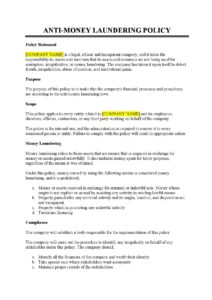Charities are often targeted by money launderers due to their perceived lack of resources and expertise in combatting financial crime. As a result, it is important for charities to have a robust anti-money laundering (AML) policy in place. This policy should set out the charity’s procedures for identifying and mitigating the risk of money laundering, and should be reviewed and updated regularly.
An effective AML policy should include the following elements:
- A risk assessment, which identifies the charity’s exposure to money laundering and terrorist financing risks;
- Customer due diligence (CDD) procedures, which require charities to collect and verify information about their donors and beneficiaries;
- Transaction monitoring systems, which can flag suspicious transactions;
- A reporting system, which allows charities to report suspicious transactions to the relevant authorities;
- Training for staff, so that they are aware of their responsibilities under the AML policy.
Risk Assessment
The first step in developing an effective anti money laundering policy template for charities is to conduct a risk assessment. This assessment should identify the charity’s exposure to money laundering and terrorist financing risks. The assessment should consider the following factors:
- The charity’s size and location;
- The types of donations the charity receives;
- The countries in which the charity operates;
- The charity’s relationships with other organizations.
Once the risk assessment is complete, the charity should develop and implement policies and procedures to mitigate the identified risks.
Customer Due Diligence
Customer due diligence (CDD) is the process of collecting and verifying information about donors and beneficiaries. This information is used to assess the risk of money laundering and terrorist financing. CDD procedures should include the following:
- Collecting the donor’s or beneficiary’s name, address, date of birth, and occupation;
- Verifying the donor’s or beneficiary’s identity through government-issued identification documents;
- Understanding the donor’s or beneficiary’s source of funds;
- Monitoring the donor’s or beneficiary’s transactions for suspicious activity.
Charities should have a system in place for escalating suspicious transactions to the relevant authorities.
Conclusion
An effective anti money laundering policy template for charities is essential for protecting charities from the risk of money laundering and terrorist financing. Charities should develop and implement a policy that is tailored to their specific risks, and should review and update the policy regularly.
By taking these steps, charities can help to protect themselves and their donors from financial crime.
FAQ
What is the purpose of an anti-money laundering policy for charities?
An anti-money laundering policy for charities is designed to protect charities from the risk of money laundering and terrorist financing. It sets out the charity’s procedures for identifying and mitigating this risk.
What are the key elements of an effective anti-money laundering policy for charities?
The key elements of an effective anti-money laundering policy for charities include: a risk assessment, customer due diligence procedures, transaction monitoring systems, a reporting system, and training for staff.
How can charities mitigate the risk of money laundering and terrorist financing?
Charities can mitigate the risk of money laundering and terrorist financing by implementing a robust anti-money laundering policy, conducting regular risk assessments, and training staff on their responsibilities under the policy.

